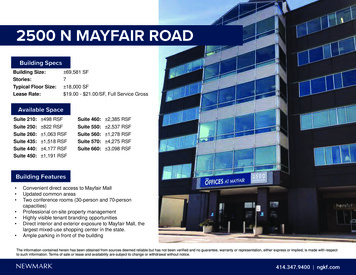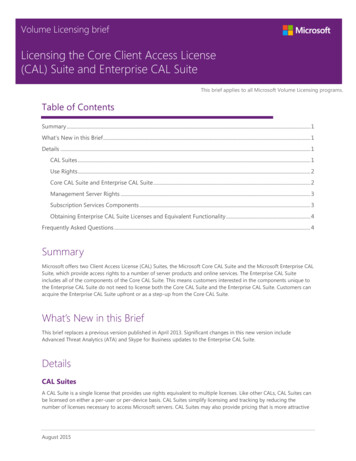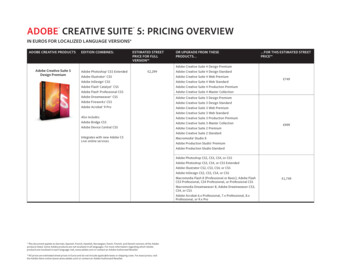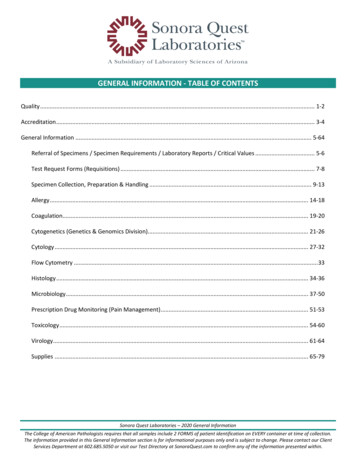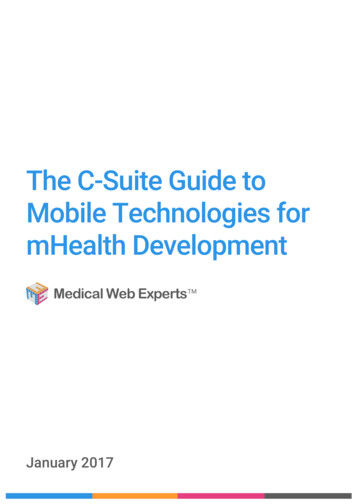
Transcription
The C-Suite Guide toMobile Technologies formHealth DevelopmentMedical Web ExpertsTMJanuary 2017
The C-Suite Guide to Mobile Technologies for mHealth DevelopmentExecutive SummarymHealth technologies are forming a more integral part of many healthcare organizations’ health ITroadmap. This Guide is designed to concisely present relevant information explaining the benefits,limitations and differences between three different technologies available for mHealth applicationdevelopment. This guide covers:Native ApplicationDevelopmentCross-platformApplication DevelopmentReact NativeApplication DevelopmentThe information presented is intended to serve as an overview and starting point for determining theright set of development technologies for your mHealth application.IntroductionMobile technologies have significantly impacted almost all consumer-driven industries over the lastdecade. As healthcare continues to integrate IT and digital solutions to improve outcomes, reducecosts, and engage patients, mHealth applications will continue to play an important role in the IT anddigital strategies of healthcare delivery networks.Over 165,000 mHealthapplications on the marketiOS mHealth applications grew 106%from 2013 to 20152%Only 2% of mHealth applicationsare integrated with provider health IT systemsSource: QuintilesIMSIn this guide, Medical Web Experts provides a brief overview of the available technologies for buildingmHealth applications, and an unbiased assessment of the strengths and weaknesses of each.
The C-Suite Guide to Mobile Technologies for mHealth DevelopmentNative ApplicationsNative applications run directly on a mobile device without a browser component. They are built for a specificoperating system (iOS, Android, or Windows), whichallows access to device features like the camera, GPS,and gesture functions (swipe, enlarge etc.).Android55.3%iOS43.5%iOS - Objective-C/SwiftAndroid - JavaWindows - C#The two most common platforms for native applicationdevelopment are Android (55.3% market share) and iOS(43.5% market share). For Android development, Java isthe core programming language used. For iOS,Objective-C and Swift are the core languages, with thefocus shifting towards Swift.Source: 9to5Mac.comBenefits of a Native AppPerformanceBetter performance than a non-nativeapplication, because the native app runsdirectly on the device operating system.UI consistencyExcellent user experience with UI/UXdesign that is optimized for each operatingsystem.Device AccessEasily able to access device features forcomplex functionalities -- for example,your app can access the GPS so that apatient can find your nearest care location.Drawbacks of a Native AppCostHigher cost, because developers areneeded for both Android and iOS, andcode written for one system can’t beused for the other.Limited data aggregationLimited data aggregation capabilitiesacross other Health IT systems. If yourorganization is looking to leverage itsmHealth application for patient dataanalytics, native applications may presentlimitations.
The C-Suite Guide to Mobile Technologies for mHealth DevelopmentCross Platform ApplicationsCross platform applications are those that allow web apps to run on mobile. They do this by wrappingthe web application in something called a “native container” -- an additional layer of technology thatallows web applications to run as mobile applications. This native container also allows access to anarray of device features similar to those available to a native app. However, this access is heavilyreliant on third party plugins that are often out-of-date or nonexistent.Cross PlatformThese cross platform applications allow greater flexibility for web developers -- and they present anopportunity for software development teams to create mobile applications with the same set oftechnologies they are already using to develop for the web. They improve efficiency by quickly allowingany development project to serve as both a web and mobile application.Mobile AppHTMLContent & StructureCSSPresentationJavaScriptBehaviorPerhaps the biggest virtue of choosing to develop cross platform mobile applications is that theHTML, CSS and JavaScript that your web developers are already writing are the languages they willuse to create mobile apps. So the same code your team is using for your website can also be used tocreate a mobile application.
The C-Suite Guide to Mobile Technologies for mHealth DevelopmentTools like Ionic, Cordova, PhoneGap and Xamarin are widelyused options that provide the native container necessary toallow your web application to run on mobile devices but haveit look like an app. As such, it can be downloaded through theapp store and use plugins to access device features usingthese tools.IonicCordovaPhoneGapXamarinBenefits of cross platform application developmentWeb applications caneasily be turned into mobileapplications.One coding language forweb and mobile apps.Reduced cost, as yourexisting web developmentteam can also create yourmobile applications.Drawbacks of cross platform applicationsInferior UI/UX is an issue for cross platform frameworks because they can’t access operatingsystem-specific design elements for user interface creation. This means that the UI/UX canfall short of user expectations. Ionic and other new tools are making improvements in thisarea, but there is still room for improvement.Lowest performance in terms of battery usage, processing speed, and user experience, asthe container adds an extra layer of technology at runtime. Every time an app is run, thenative container also opens your browser in the background.Little access to device features like the camera and GPS, as the only way to access theseis through plugins. These are often out-of-date, unreliable or nonexistent.Cannot be used offline. Requires internet connection in order for the native container toconnect with the web browser, which enables the app to run.
The C-Suite Guide to Mobile Technologies for mHealth DevelopmentReact NativeReact Native is a new generation of mobile developmenttechnology created by Facebook, based on the the popularReactJS library for web development. It has grown continuouslyin its usage and adoption since early 2015.ReactJSThe platform allows developers the ability to create UI/UX with visuals that are standard for eachoperating system, translating to a much better user experience compared to cross platform applications.React Native also allows robust access to device features while allowing web developers to create asingle code base in JavaScript that can be used for both Android and iOS.In essence, React Native combines thecost-effectiveness of cross platform mobiledevelopment with the platform and operatingsystem-specific capabilities of native mobileapp development -- the best of both worlds, ifyou will.React Native: (United States), Objective-C: (United States),Swift: (United States), Android software development: (United States)1007550React NativeObjective-CSwiftAndroid softwaredevelopment2520122013201420152016
The C-Suite Guide to Mobile Technologies for mHealth DevelopmentBenefits of React Native developmentOne code baseUI/UXAccess to deviceOpen-source codebaseCustom mHealth appOne code base across all platformsAbility to create native application UI/UXAccess to device features, like the camera and GPSReduced development costs compared with native app development, as one set of technologiescan be used across both iOS and AndroidOpen-source codebase that is well supported and constantly evolving, with a robust developercommunity contributing to the code and the stability and functionality of the platform.Increased versatility as custom mHealth app data can be submitted to a custom administrativeportal for population health, care coordination, data analytics and more.Increased data sharing and aggregation capabilities. Backend API can be integrated withother existing Health IT systems and applications across the organization.
The C-Suite Guide to Mobile Technologies for mHealth DevelopmentDrawbacks of React Native developmentFaster performance than cross platform, but still slower than native applications.The React engine -- which generates operating system-native code from JavaScript-- adds an extra layer of technology between the application code and the deviceoperating system.Platform stability that still has not reached a v. 1.0. Because this new platform isstill in beta, there are frequent changes and updates. This means that, for now,application maintenance can be resource intensive and your developers need tokeep up with new releases and updates.As with all technologies, native, cross platform, and React Native mobile apps all havetheir pros and cons. One won’t necessarily always be the right choice. Instead, youshould choose your app development technology based on the functionalities you willneed for your new mHealth application.Medical Web Experts is a team of trusted industry leaders that has been providinghealthcare professionals with top notch web and mobile solutions since 2003.To learn more about our custom mhealth application development work,get in touch to start a conversation.Medical Web ExpertsTMCONTACT US
Xamarin . React Native React Native is a new generation of mobile development technology created by Facebook, based on the the popular ReactJS library for web development. It has grown continuously . their pros and cons. One won't necessarily always be the right choice. Instead, you



